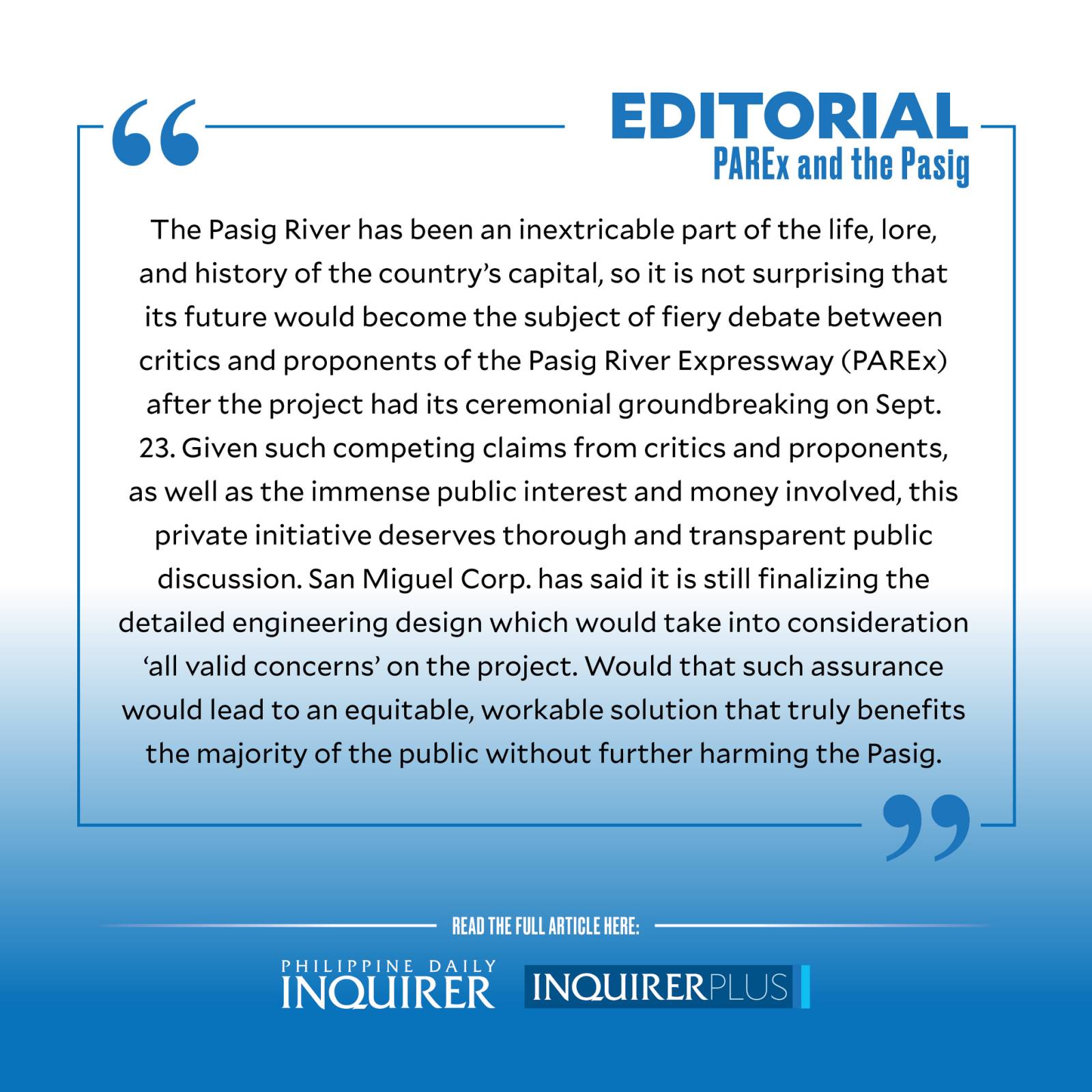PAREx and the Pasig

The Pasig River has been an inextricable part of the life, lore, and history of the country’s capital, so it is not surprising that its future would become the subject of fiery debate between critics and proponents of the Pasig River Expressway (PAREx) after the project had its ceremonial groundbreaking on Sept. 23.
The planned 19.3-kilometer-long elevated highway will connect Road 10 in Tondo, Manila, to Circumferential Road 6 in Taytay, Rizal, and will thread through the cities of Manila, Makati, Pasig, and Taguig as it traverses the Pasig River.
San Miguel Corp. (SMC) president Ramon Ang has described the P95-billion SMC project as a means to provide “safe and efficient transport infrastructure,” but its critics—including some 80 civil society organizations and environmental groups—have raised serious concerns on the expressway’s possible adverse impacts.
In several press statements, Ang has called out “those who only cry for the long-dead Pasig river to be ‘saved’ now—after being indifferent to it and our many other rivers that have suffered the same fate, for so many decades.” SMC, he said, will continue its ongoing clean-up efforts to revive the river, which plays a crucial role in draining excess water from Laguna Lake into Manila Bay. The company is spending about P2 billion to dredge at least three million metric tons of solid waste, and SMC has the resources and engineering expertise to “take care of the river for the long term,” Ang stressed.
The PAREx would also address the demand for other forms of transport as it will be a “hybrid expressway” that will accommodate several modes of transportation, Ang added. And it will not run along Intramuros but along Binondo on the other side of the river, which will “avoid any significant impact on Intramuros and … [allow] the PAREx to showcase our heritage sites to users, including tourists.” While conceding that the project could decongest traffic early on, AltMobility PH cautioned that the projected ease of travel would eventually encourage people to buy more cars—thus further increasing traffic on Metro Manila’s roads and greenhouse gases from vehicle fumes.
Meanwhile, heritage advocacy group Renacimiento Manila noted that over 40 heritage structures may be put at risk once construction of the expressway commences. This includes Intramuros’ walls and forts, Fort Santiago, Aduana, the National Press Club, and the Chamber of Commerce. The vibrations from the construction could affect historic structures around the river as well, the group pointed out.
Architect and urban planner Paulo Alcazaren cited the impending “threat” to Manila’s last lung, the Arroceros Forest Park, and its close to 8,000 plants and mature trees and 10 bird species. As for SMC’s explanation that the project would incorporate lanes for buses, bikes, and pedestrians, “To connect a pedestrian system from the banks of the river … one would have to go on several flights and the equivalent of about five stories to get up there,” said Alcazaren.
Groups were dismayed as well at SMC’s statement that the Pasig River is “considered biologically dead,” saying that it diminishes efforts by government and private entities to clean up and rehabilitate the waterway, which showed significant improvements before President Duterte dissolved the Pasig River Rehabilitation Commission in 2019.
Agham, or the Advocates of Science and Technology for the People, a national organization of scientists, researchers, engineers, and science educators, warned that the PAREx could suffocate the river. “Complete or partial blocking of the natural sunlight will affect the remaining food chain of Pasig River,” the group said. “From the tiniest plankton to the remaining fish species and riparian vegetation, all organisms will be affected by the drastic alteration of the river’s illumination.”
Is there a more viable alternative? Alcazaren offers PARES or the Pasig River Esplanade, a proposed linear park that will make use of the 10-meter easement along both sides of the river set by the Metro Manila Development Council in 2015 to provide space for use by bikers and pedestrians, and for underground modular treatment facilities for storm and wastewater treatment that can help ensure the river’s health. Alcazaren’s firm worked on the Iloilo Esplanade, which redeveloped and reinvigorated the city’s neglected riverbank.
Given such competing claims from critics and proponents, as well as the immense public interest and money involved, this private initiative deserves thorough and transparent public discussion. SMC has said it is still finalizing the detailed engineering design which would take into consideration “all valid concerns” on the project. Would that such assurance would lead to an equitable, workable solution that truly benefits the majority of the public without further harming the Pasig.















